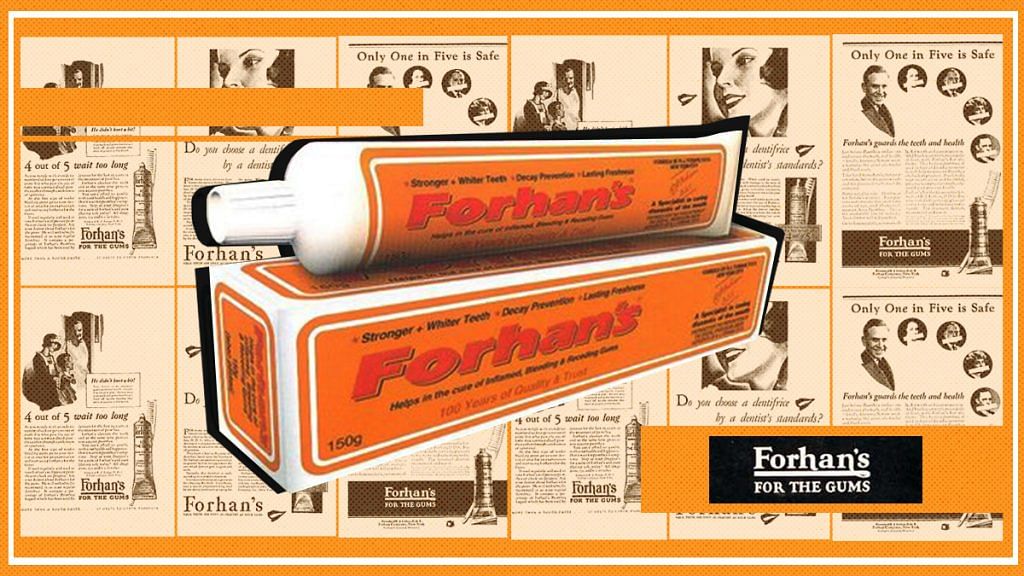New Delhi: Can toothpaste be foamless and not sweet in taste? Of course. Ask anyone from the 1960s, and they will immediately recall Forhan’s, one of India’s oldest toothpaste brands.
In an era when US multinational consumer goods company Colgate ruled the toothpaste market in India, Forhan’s managed to strike a chord with Indian consumers with its unconventional branding. The toothpaste was marketed as a product created by dentists, which was a novel idea in those days and helped the brand garner trust instantly.
It was the first toothpaste in India made using fluoride, a chemical that naturally helps in preventing cavities and protecting teeth enamel. This was what gave it a slightly bitter taste.
“I will always associate my orange tube of Forhan’s toothpaste with my wonderful school days in Madurai because that was the brand our family used back then. My sisters and I grumbled a little that it did not foam,” wrote Harish Bhatt, former managing director of Tata Global Beverages and chief operating officer of Titan Company Ltd, in his book, The Curious Marketer.
Bhatt confessed that he and his sister were also secretly happy using the toothpaste. “…It was created by a dentist and very good for our gums. If the Forhan’s brand was relaunched today, the nostalgia may well lead me and many others, I think, to try it once again,” he wrote.
The company later improvised the brand and relaunched “foaming toothpaste” as well.
Also read: Godrej Vatni was India’s foremost Swadeshi soap, and it didn’t remind you of Partition
A breath of fresh air and a favourite with celebrities
Recalling the brand’s early marketing days, veteran ad-maker Prahlad Kakkar said, “Popular Indian director Shyam Benegal was involved in the marketing of the brand during his stint with the advertising agency called Advertising, Sales and Promotion (ASP).
“Benegal was associated with ASP in 1963 and was primary person in designing ads for Forhan’s. It was his remarkable promotion strategy which helped the brand survive behemoth Colgate despite bitter taste.”
In 1986, Forhan’s released one of its most popular advertisements featuring ace cricketer Sunil Gavaskar with his 10-year-old son, Rohan. “I am a super fighter and I want my son to be one, too. I give my son Forhan’s care. Do you?” asks Gavaskar in the ad.
A year later, one of its television commercials called it a “confidence booster for youngsters”. The ad showed a group of young friends bowling, laughing and singing, “It’s got mint, it’s got freshness you never felt before. It’s a fresh mint feeling for confidence and more.”
One of its Hindi print ads showed a smiling child being dressed by his mother. The ad read “Daanton Ko Chahiye Jeevanbhar Mazboot Aadhar (Teeth need a strong foundation all through life).”
The popular punchline of the brand was: “Like a breath of fresh air”.
Also read: Roz khao ande: When a pro-egg campaign was a hit with Indian vegetarians
Changed several hands but went downhill
Mumbai-based Geoffrey Manners And Company Ltd began manufacturing Forhan’s in the 1960s.
The market for toothpaste was getting congested in the early 1970s when the light green Binaca also started gaining popularity alongside Colgate, Pepsodent and Macleans. Toothpaste brands started spending big on ad campaigns, with Binaca Geetmala, the weekly film music countdown show being most famous.
In 2002, an American pharmaceuticals company, Wyeth, which specialised in prescription products, announced a merger with Geoffrey Manners to gain a foothold in the over-the-counter market.
However, Wyeth later realised that “with its diversified pharma portfolio, Forhan’s did not fit into its core business plans”, according to a report by The Economic Times in 2003.
By then, the sales of the toothpaste brand went downhill and it registered a market share of just 4 per cent. “Whatever little presence it has, is mostly in the urban markets; its visibility in the rural markets is negligible,” the report stated.
Wyeth sold the toothpaste brand to Indian chemicals manufacturer John Oak Remedies (JOR) in 2005.
Two years later, electronics major Anchor Group acquired Forhan’s from JOR. Anchor re-launched the brand under its FMCG arm, Anchor Health & Beauty Care (AHBC), but it faced tough competition from market leaders Colgate and Pepsodent. The company wasn’t able to revive the brand and it became, despite its taste, a sweet memory.
